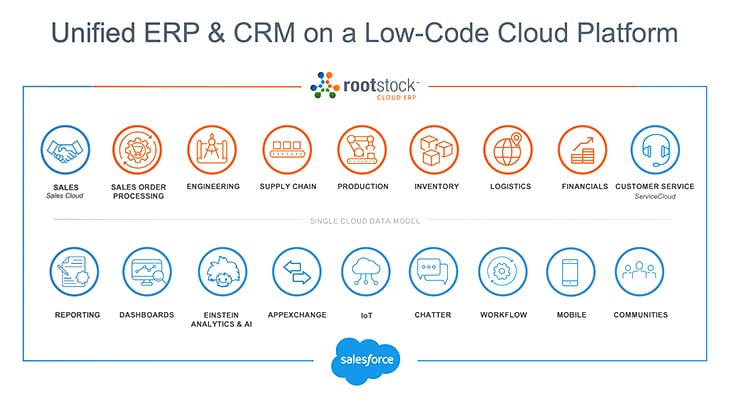To paraphrase the late futurist Alvin Toffler, “The rate of change is changing faster.” That applies not just to technology, but to business and the world in general.
Low-Code ERP comes at a time when businesses desperately need the ability to be more agile and use Cloud ERP software to differentiate their business. The pace of business and the ability to adjust business models, product mixes, and add new customer services has never been so intense. Old ERP systems simply can’t cut it anymore, especially in this new world of remote workforces.
To explore this topic further, Tyler Smith of ERP Focus hosted Tom Brennan, former CMO of Rootstock, and Peter Coffee, SVP of Strategic Research at Salesforce in a webinar to discuss this world of constant change and how Cloud-Based, Low-Code ERP can help manufacturers adapt and differentiate their businesses. We’ll recap the most important discussion points from the webinar, including what low-code ERP is, why it’s becoming necessary for organizations to adopt it, and the primary advantages of low-code platforms.
Watch the Full Webinar, “What is Low-Code ERP and why should you consider it now?”
What is Low-Code ERP?
So, just what is low-code ERP?
A low-code ERP system utilizes simple logic and intuitive drag-and-drop features so that anyone can build their own custom applications within an ERP system without needing IT help. Low-code ERP allows you to choose something from a menu of options or go through a structured configuration process to meet your specifications, rather than starting from scratch or having to rely on coding experts. Functionality components act like building blocks to make it much faster to modify, create and publish applications compared to the traditional legacy development/change management cycle.
Most importantly, low-code ERP enables the business user to do more without needing IT help. “It’s very important that people be able to think about the process and the data integrity issues, instead of wondering where that semi-colon goes,” said Peter Coffee. “Low-code and no-code have such an important role to play in letting people who are closest to the problem be much more directly involved in how that problem gets solved.”
The Rise of Low-Code ERP Explained
The speakers addressed two of the underlying change agents impacting manufacturers, the Digital Imperative and COVID-19. Customers and employees are more digitally savvy than ever before and expect a certain degree of interactivity with your company and even your product. For most companies today, the product isn’t just a box anymore. Increasingly, products have some software and/or service, even cloud components. COVID-19 has added more fuel to the digital fire by creating the need to connect with employees, customers, suppliers, and distribution remotely through mobile apps and digital communities.
The speakers encouraged businesses to think big and to innovate as they digitally transform. Peter Coffee explained that “Digital Transformation” is not enough. If you simply transform current processes and behavior onto new technology “you just get a lower cost of doing the wrong thing.” You can’t just arrive at a new level. You need to continue to innovate. A better phrase is “Digital Enablement” which calls for a continuous transformation of both the technology and the culture, which means systems like ERP need to constantly evolve.
The ERP Tar Pit
While the world is changing rapidly around them, many companies are stuck in what the speakers called an ERP Tar pit, caused by legacy ERP systems.
Coffee notes that with off-the-shelf systems, you either run like everyone else or customize and get trapped in the ERP Tar Pit. “Once you take an off-the-shelf ERP system and add any significant intellectual property through process or data customization, you’ve impeded your ability to take advantage of the next upgrade cycle.”
One small change to an on-premise ERP system often requires coding, and an expensive consultant to make the change then forces updates to reports and even workflow. Because of this, only about one-third of users of legacy ERP are running the current version of their software and are literally stuck on old releases.
Simply put, the legacy ERP systems running in most companies today are not built for the rapidly changing environment. Companies that stay with an older, on-premise ERP system lose the opportunity for the rapid innovation that the cloud enables.
Download our free guide to help you determine if your Legacy ERP is keeping your company from achieving its financial growth goals.








